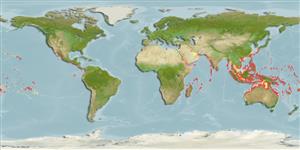Common names from other countries
Environment: milieu / climate zone / depth range / distribution range
นิเวศวิทยา
เกี่ยวกับทะเล,น้ำเค็ม เกี่ยวกับหินโสโครก; ระดับความลึก 0 - 48 m (Ref. 58302), usually ? - 10 m (Ref. 30404). Tropical; 32°N - 33°S, 27°E - 76°W
Indo-Pacific: Red Sea and East Africa (Ref. 33390) and Persian Gulf (Ref. 68964) to the Society Islands, north to southern Japan and the Hawaiian Islands, south to Lord Howe Island; throughout Micronesia. Eastern Central Pacific: southern Baja California, Mexico and from Costa Rica to northern Colombia (Ref. 9324). Also found in Southeast Atlantic.
ขนาด / น้ำหนัก / Age
Maturity: Lm ? range ? - ? cm
Max length : 100.0 cm TL เพศผู้/กระเทย; (Ref. 48635); common length : 50.0 cm TL เพศผู้/กระเทย; (Ref. 3258)
เงี่ยงครีบหลัง (รวม) : 0; ก้านครีบอ่อนที่หาง (รวม) : 0; เงี่ยงครีบก้น: 0; ก้านครีบอ่อนที่ก้น: 0; สัตว์มีกระดูกสันหลัง: 119 - 126. Body white with 2 rows of large dendritic black blotches; black spots between blotches become irregularly linear with age. Yellow eyes (Ref. 48635).
Found between rocks and corals of intertidal reef flats, also in shallow lagoon and seaward reefs to depths of at least 10 m (Ref. 9710, 58302). Benthic (Ref. 58302). Nocturnal (Ref. 68964). Feed mainly on crustaceans. Protogynous hermaphroditism unconfirmed for this species (Ref. 84746). Safely kept with small aquarium fishes (Ref. 9710). Solitary, seen usually in the open or with only head exposed (Ref 90102). Minimum depth reported taken from Ref. 86942.
Life cycle and mating behavior
Maturities | การสืบพันธุ์ | Spawnings | Egg(s) | Fecundities | ตัวอ่อน
Protogyny unconfirmed (Ref. 84746).
Chen, H.-M., K.-T. Shao and C.T. Chen, 1994. A review of the muraenid eels (Family Muraenidae) from Taiwan with descriptions of twelve new records. Zool. Stud. 33(1):44-64. (Ref. 6934)
IUCN Red List Status (Ref. 130435)
CITES (Ref. 128078)
Not Evaluated
Threat to humans
Harmless
Human uses
การประมง: มีการค้าเพียงเล็กน้อย; สถานที่แสดงสัตว์และพืชน้ำ: การค้า
เครื่องมือ
Special reports
Download XML
แหล่งที่มาจากอินเตอร์เน็ต
Estimates based on models
Preferred temperature (Ref.
115969): 24.9 - 29.3, mean 28.4 (based on 3674 cells).
Phylogenetic diversity index (Ref.
82804): PD
50 = 0.5005 [Uniqueness, from 0.5 = low to 2.0 = high].
Bayesian length-weight: a=0.00034 (0.00022 - 0.00052), b=3.31 (3.19 - 3.43), in cm Total Length, based on LWR estimates for this species & (Sub)family-body (Ref.
93245).
ระดับชั้นอาหาร (Ref.
69278): 4.2 ±0.71 se; based on food items.
ความสามารถในการกลับคืนสู่ปกติ (Ref.
120179): ต่ำ, เวลาต่ำสุดที่จะทำให้ประชากรเพิ่มขึ้นเป็น 2 เท่าใช้เวลา 4.5 - 14 ปี (Preliminary K or Fecundity.).
Fishing Vulnerability (Ref.
59153): High vulnerability (60 of 100).
